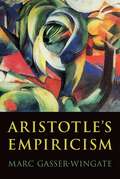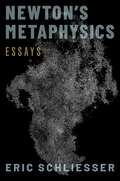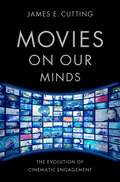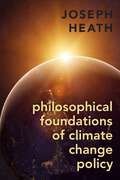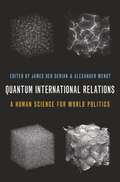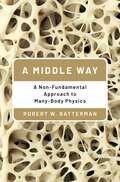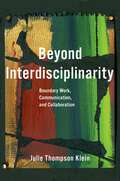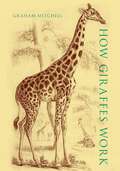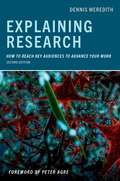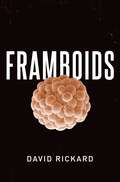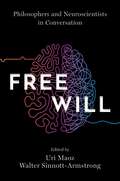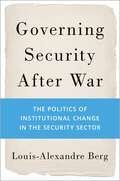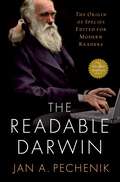- Table View
- List View
Aristotle's Empiricism
by Marc Gasser-WingateAristotle is famous for thinking that all our knowledge comes from perception. But it's not immediately clear what this view is meant to entail. It's not clear, for instance, what perception is supposed to contribute to the more advanced forms of knowledge that derive from it. Nor is it clear how we should understand the nature of its contributionwhat it might mean to say that these more advanced forms of knowledge are "derived from" or "based on" what we perceive. Aristotle is often thought to have disappointingly little to say on these matters. Gasser-Wingate makes the case that this thought is mistaken: a coherent and philosophically attractive view of perceptual knowledge can be found in the various texts in which Aristotle discusses perception's role in animal life, the cognitive resources on which it does and does not depend, and the relation it bears to practical and theoretical modes of understanding. Aristotle's Empiricism offers a sustained examination of these discussions and their epistemological, psychological, and ethical implications. It defends an interpretation of Aristotle as a moderate sort of empiricist, who thinks we can develop sophisticated forms of knowledge by broadly perceptual meansand that we therefore share an important part of our cognitive lives with nonrational animalsbut also holds that our intellectual powers allow us to surpass these animals in certain ways and thereby develop distinctively human forms of understanding.
Aristotle's Empiricism
by Marc Gasser-WingateAristotle is famous for thinking that all our knowledge comes from perception. But it's not immediately clear what this view is meant to entail. It's not clear, for instance, what perception is supposed to contribute to the more advanced forms of knowledge that derive from it. Nor is it clear how we should understand the nature of its contributionwhat it might mean to say that these more advanced forms of knowledge are "derived from" or "based on" what we perceive. Aristotle is often thought to have disappointingly little to say on these matters. Gasser-Wingate makes the case that this thought is mistaken: a coherent and philosophically attractive view of perceptual knowledge can be found in the various texts in which Aristotle discusses perception's role in animal life, the cognitive resources on which it does and does not depend, and the relation it bears to practical and theoretical modes of understanding. Aristotle's Empiricism offers a sustained examination of these discussions and their epistemological, psychological, and ethical implications. It defends an interpretation of Aristotle as a moderate sort of empiricist, who thinks we can develop sophisticated forms of knowledge by broadly perceptual meansand that we therefore share an important part of our cognitive lives with nonrational animalsbut also holds that our intellectual powers allow us to surpass these animals in certain ways and thereby develop distinctively human forms of understanding.
Newton's Metaphysics: Essays
by Eric SchliesserIn this collection of new and previously published essays, noted philosopher Eric Schliesser offers new interpretations of the signifance of Isaac Newton's metaphysics on his physics and the subsequent development of philosophy more broadly. Schliesser address Newton's account of space, time, gravity, motion, inertia, and laws-all evergreens in the literature; he also breaks new ground in focusing on Newton's philosophy of time, Newton's views on emanation, and Newton's modal metaphysics. In particular, Schliesser explores the rich resonances between Newton's and Spinoza's metaphysics. Schliesser presents a new argument of the ways in which Newton and his circle respond to the treatment and accusations of Spinozism, illuminating both the details of Newton's metaphysics and the content of Spinoza's. Schliesser provides a fine-grained analysis of some of the key metaphysical concepts in Newton's physics, including controversial interpretations of Newton's ideas on space, time, inertia, and necessity. Schliesser restates his provocative interpretation of Newton's views on action at a distance as he was developing the Principia. Newton's Metaphysics contains a substantive introduction, two chapters co-authored with Zvi Biener and with Mary Domski, new chapters on Newton's modal metaphysics and his theology, and two postscripts in which Schliesser responds to some of his most important critics, including Katherine Brading, Andrew Janiak, Hylarie Kochiras, Steffen Ducheyne, and Adwait Parker. The collection presents new and varied analyses on familiar focuses of Newton's work, adding important perspectives to the recent revival of interest in Spinoza's metaphysics.
Newton's Metaphysics: Essays
by Eric SchliesserIn this collection of new and previously published essays, noted philosopher Eric Schliesser offers new interpretations of the signifance of Isaac Newton's metaphysics on his physics and the subsequent development of philosophy more broadly. Schliesser address Newton's account of space, time, gravity, motion, inertia, and laws-all evergreens in the literature; he also breaks new ground in focusing on Newton's philosophy of time, Newton's views on emanation, and Newton's modal metaphysics. In particular, Schliesser explores the rich resonances between Newton's and Spinoza's metaphysics. Schliesser presents a new argument of the ways in which Newton and his circle respond to the treatment and accusations of Spinozism, illuminating both the details of Newton's metaphysics and the content of Spinoza's. Schliesser provides a fine-grained analysis of some of the key metaphysical concepts in Newton's physics, including controversial interpretations of Newton's ideas on space, time, inertia, and necessity. Schliesser restates his provocative interpretation of Newton's views on action at a distance as he was developing the Principia. Newton's Metaphysics contains a substantive introduction, two chapters co-authored with Zvi Biener and with Mary Domski, new chapters on Newton's modal metaphysics and his theology, and two postscripts in which Schliesser responds to some of his most important critics, including Katherine Brading, Andrew Janiak, Hylarie Kochiras, Steffen Ducheyne, and Adwait Parker. The collection presents new and varied analyses on familiar focuses of Newton's work, adding important perspectives to the recent revival of interest in Spinoza's metaphysics.
Movies on Our Minds: The Evolution of Cinematic Engagement
by James E. CuttingThis book traces the development of popular cinema from its inception to the present day to understand why humankind has expanded its viewing of popular movies over the last century. Drawing from his extensive work as a psychologist studying artistic canons, James E. Cutting presents hundreds of films across a wide range of genres and eras, considers the structure of frame content, shots, scenes, and larger narrational elements defined by color, brightness, motion, clutter, and range of other variables. He examines the effects of camera lenses, image layout, transitions, and historical functions to classify different kinds of shots. He explains the arcs of scenes, the larger structure of sequences, and the scene- and sequence-like units that have become increasingly prevalent in recent years. The book then breaks movies into larger, roughly half-hour parts and espouses the psychological evidence behind each device's intended effect, ultimately exploring the rhythms of whole movies, the flow of physical changes, and the cinematic polyrhythms that have come to match aspects those in the human body. Along the way, the book considers cultural and technological evolutions that have contributed to shifts in viewers' engagement by sustaining attention, promoting understanding of the narrative, heightening emotional commitment, and fostering felt presence in the story. Movies on Our Minds asks critical questions about how our emotional processes and the way our experiences of movies have changed over the course of cinematic history, for a cutting-edge look at what makes popular movies enjoyable.
Movies on Our Minds: The Evolution of Cinematic Engagement
by James E. CuttingThis book traces the development of popular cinema from its inception to the present day to understand why humankind has expanded its viewing of popular movies over the last century. Drawing from his extensive work as a psychologist studying artistic canons, James E. Cutting presents hundreds of films across a wide range of genres and eras, considers the structure of frame content, shots, scenes, and larger narrational elements defined by color, brightness, motion, clutter, and range of other variables. He examines the effects of camera lenses, image layout, transitions, and historical functions to classify different kinds of shots. He explains the arcs of scenes, the larger structure of sequences, and the scene- and sequence-like units that have become increasingly prevalent in recent years. The book then breaks movies into larger, roughly half-hour parts and espouses the psychological evidence behind each device's intended effect, ultimately exploring the rhythms of whole movies, the flow of physical changes, and the cinematic polyrhythms that have come to match aspects those in the human body. Along the way, the book considers cultural and technological evolutions that have contributed to shifts in viewers' engagement by sustaining attention, promoting understanding of the narrative, heightening emotional commitment, and fostering felt presence in the story. Movies on Our Minds asks critical questions about how our emotional processes and the way our experiences of movies have changed over the course of cinematic history, for a cutting-edge look at what makes popular movies enjoyable.
Philosophical Foundations of Climate Change Policy
by Joseph HeathThere is widespread agreement that something must be done to combat anthropogenic climate change. And yet what is the extent of our obligations? It would clearly be unjust for us to allow global warming to reach dangerous levels. But what is the nature of this injustice? Providing a plausible philosophical specification of the wrongness of our present inaction has proven surprisingly difficult. Much of this is due to the temporal structure of the problem, or the fact that there is such a significant delay between our actions and the effects that they produce. Many normative theories that sound plausible when applied to contemporaneous problems generate surprising or perverse results when applied to problems that extend over long periods of time, involving effects on individuals who have not yet been born. So while states have a range of sensible climate change policies at their disposal, the philosophical foundations of these policies remains indeterminate. By far the most influential philosophical position has been the variant of utilitarianism most popular among economists, which maintains that we have an obligation to maximize the well-being of all people, from now until the end of time. Climate change represents an obvious failure of maximization. Many environmental philosophers, however, find this argument unpersuasive, because it also implies that we have an obligation to maximize economic growth. Yet their attempts to provide alternative foundations for policy have proven unpersuasive. Joseph Heath presents an approach to thinking about climate change policy grounded in social contract theory, which focuses on the fairness of existing institutions, not the welfare of future generations, in order to generate a set of plausible policy prescriptions.
Philosophical Foundations of Climate Change Policy
by Joseph HeathThere is widespread agreement that something must be done to combat anthropogenic climate change. And yet what is the extent of our obligations? It would clearly be unjust for us to allow global warming to reach dangerous levels. But what is the nature of this injustice? Providing a plausible philosophical specification of the wrongness of our present inaction has proven surprisingly difficult. Much of this is due to the temporal structure of the problem, or the fact that there is such a significant delay between our actions and the effects that they produce. Many normative theories that sound plausible when applied to contemporaneous problems generate surprising or perverse results when applied to problems that extend over long periods of time, involving effects on individuals who have not yet been born. So while states have a range of sensible climate change policies at their disposal, the philosophical foundations of these policies remains indeterminate. By far the most influential philosophical position has been the variant of utilitarianism most popular among economists, which maintains that we have an obligation to maximize the well-being of all people, from now until the end of time. Climate change represents an obvious failure of maximization. Many environmental philosophers, however, find this argument unpersuasive, because it also implies that we have an obligation to maximize economic growth. Yet their attempts to provide alternative foundations for policy have proven unpersuasive. Joseph Heath presents an approach to thinking about climate change policy grounded in social contract theory, which focuses on the fairness of existing institutions, not the welfare of future generations, in order to generate a set of plausible policy prescriptions.
Quantum International Relations: A Human Science for World Politics
The contributors to this volume are motivated by a common apprehension and a common hope. The apprehension was first voiced by Einstein, who lamented the inability of humanity, at the individual and social level, to keep up with the increased speed of technological change brought about by the quantum revolution. As quantum science and technology fast forward into the 21st century, the social sciences remain stuck in classical, 19th century ways of thinking. Can such a mechanistic model of the mind and society possibly help us manage the fully realized technological potential of the quantum? That's where the hope appears: that perhaps quantum is not just a physical science, but a human science too. In Quantum International Relations, James Der Derian and Alexander Wendt gather rising scholars and leading experts to make the case for quantum approaches to world politics. As a fundamental theory of reality and enabler of new technologies, quantum now touches everything, with the potential to revolutionize how we conduct diplomacy, wage war, and make wealth. Contributors present the core principles of quantum mechanics--entanglement, uncertainty, superposition, and the wave function--as significant catalysts and superior heuristics for an accelerating quantum future. Facing a reality which no longer corresponds to an outdated Newtonian worldview of states as billiard balls, individuals as rational actors or power as objective interest, Der Derian and Wendt issue an urgent call for a new human science of quantum International Relations. At the centenary of the first quantum thought experiment in the 1920s, this book offers a diversity of explorations, speculations and approaches for understanding geopolitics in the 21st century.
Quantum International Relations: A Human Science for World Politics
by James Der Derian and Alexander WendtThe contributors to this volume are motivated by a common apprehension and a common hope. The apprehension was first voiced by Einstein, who lamented the inability of humanity, at the individual and social level, to keep up with the increased speed of technological change brought about by the quantum revolution. As quantum science and technology fast forward into the 21st century, the social sciences remain stuck in classical, 19th century ways of thinking. Can such a mechanistic model of the mind and society possibly help us manage the fully realized technological potential of the quantum? That's where the hope appears: that perhaps quantum is not just a physical science, but a human science too. In Quantum International Relations, James Der Derian and Alexander Wendt gather rising scholars and leading experts to make the case for quantum approaches to world politics. As a fundamental theory of reality and enabler of new technologies, quantum now touches everything, with the potential to revolutionize how we conduct diplomacy, wage war, and make wealth. Contributors present the core principles of quantum mechanics--entanglement, uncertainty, superposition, and the wave function--as significant catalysts and superior heuristics for an accelerating quantum future. Facing a reality which no longer corresponds to an outdated Newtonian worldview of states as billiard balls, individuals as rational actors or power as objective interest, Der Derian and Wendt issue an urgent call for a new human science of quantum International Relations. At the centenary of the first quantum thought experiment in the 1920s, this book offers a diversity of explorations, speculations and approaches for understanding geopolitics in the 21st century.
A Middle Way: A Non-Fundamental Approach to Many-Body Physics
by Robert W. BattermanRobert W. Batterman's monograph examines a ubiquitous methodology in physics and the science of materials that has virtually been ignored in the philosophical literature. This method focuses on mesoscale structures as a means for investigating complex many-body systems. It challenges foundational pictures of physics where the most important properties are taken to be found at lower, more fundamental scales. This so-called "hydrodynamic approach" has its origins in Einstein's pioneering work on Brownian motion. This work can be understood to be one of the first instances of "upscaling" or homogenization whereby values for effective continuum scale parameters can be theoretically determined. Einstein also provided the first statement of what came to be called the "Fluctuation-Dissipation" theorem. This theorem justifies the use of equilibrium statistical mechanics to study the nonequilibrium behaviors of many-body systems. Batterman focuses on the consequences of the Fluctuation-Dissipation theorem for a proper understanding of what can be considered natural parameters or natural kinds for studying behaviors of such systems. He challenges various claims that such natural, or joint carving, parameters are always to be found at the most fundamental level. Overall, Batterman argues for mesoscale first, middle-out approach to many questions concerning the relationships between fundamental theories and their phenomenological, continuum scale cousins.
A Middle Way: A Non-Fundamental Approach to Many-Body Physics
by Robert W. BattermanRobert W. Batterman's monograph examines a ubiquitous methodology in physics and the science of materials that has virtually been ignored in the philosophical literature. This method focuses on mesoscale structures as a means for investigating complex many-body systems. It challenges foundational pictures of physics where the most important properties are taken to be found at lower, more fundamental scales. This so-called "hydrodynamic approach" has its origins in Einstein's pioneering work on Brownian motion. This work can be understood to be one of the first instances of "upscaling" or homogenization whereby values for effective continuum scale parameters can be theoretically determined. Einstein also provided the first statement of what came to be called the "Fluctuation-Dissipation" theorem. This theorem justifies the use of equilibrium statistical mechanics to study the nonequilibrium behaviors of many-body systems. Batterman focuses on the consequences of the Fluctuation-Dissipation theorem for a proper understanding of what can be considered natural parameters or natural kinds for studying behaviors of such systems. He challenges various claims that such natural, or joint carving, parameters are always to be found at the most fundamental level. Overall, Batterman argues for mesoscale first, middle-out approach to many questions concerning the relationships between fundamental theories and their phenomenological, continuum scale cousins.
Beyond Interdisciplinarity: Boundary Work, Communication, and Collaboration
by Julie Thompson KleinBeyond Interdisciplinarity examines the broadening meaning of core concept across academic disciplines and other forms of knowledge. In this book, Associate Editor of The Oxford Handbook of Interdisciplinarity and internationally recognized scholar Julie Thompson Klein depicts the heterogeneity and boundary work of inter- and trans-disciplinarity in a conceptual framework based on an ecology of spatializing practices in transaction spaces, including trading zones and communities of practice. The book includes both "crossdisciplinary" work (encompassing multi-, inter-, and trans-disciplinary forms) as well as "cross-sector" work (spanning disciplines, fields, professions, government and industry, and communities). The first section of the book defines and explains boundary work, discourses of interdisciplinarity, and the nature of interdisciplinary fields. In the second section, Klein examines dynamics of working across disciplines, including communication, collaboration, and learning with concrete examples and lessons from research projects and programs that transcend traditional fields. The closing chapter examines reasons for failure and success then presents gateways to literature and other resources. Throughout the book, Klein emphasizes the roles of contextualization and historical change while factoring in the shifting relationship of disciplinarity and interdisciplinarity, ascendancy of transdisciplinarity, and intersections with other constructs including Mode 2 knowledge production, convergence, team science, and postdisciplinarity. The conceptual framework she provides also includes the role of boundary objects, agents, and organizations in brokering differences and creating for platforms for change. Klein further explains why translation, interlanguage, and a communication boundary space are vital to achieving intersubjectivity and collective identity. They foster not only pragmatics of negotiation and integration but also reflexivity, transactivity, and co-production of knowledge with stakeholders beyond the academy. Rhetorics of holism and synthesis compete with instrumentalities of problem solving and transgressive critiques. However, typical warrants today include complexity, contextualization, collaboration, and socially-robust knowledge. Crossing boundaries remains complex, but this book guides readers through the density of pertinent literature while expanding understandings of crossdisciplinary and cross-sector work.
Beyond Interdisciplinarity: Boundary Work, Communication, and Collaboration
by Julie Thompson KleinBeyond Interdisciplinarity examines the broadening meaning of core concept across academic disciplines and other forms of knowledge. In this book, Associate Editor of The Oxford Handbook of Interdisciplinarity and internationally recognized scholar Julie Thompson Klein depicts the heterogeneity and boundary work of inter- and trans-disciplinarity in a conceptual framework based on an ecology of spatializing practices in transaction spaces, including trading zones and communities of practice. The book includes both "crossdisciplinary" work (encompassing multi-, inter-, and trans-disciplinary forms) as well as "cross-sector" work (spanning disciplines, fields, professions, government and industry, and communities). The first section of the book defines and explains boundary work, discourses of interdisciplinarity, and the nature of interdisciplinary fields. In the second section, Klein examines dynamics of working across disciplines, including communication, collaboration, and learning with concrete examples and lessons from research projects and programs that transcend traditional fields. The closing chapter examines reasons for failure and success then presents gateways to literature and other resources. Throughout the book, Klein emphasizes the roles of contextualization and historical change while factoring in the shifting relationship of disciplinarity and interdisciplinarity, ascendancy of transdisciplinarity, and intersections with other constructs including Mode 2 knowledge production, convergence, team science, and postdisciplinarity. The conceptual framework she provides also includes the role of boundary objects, agents, and organizations in brokering differences and creating for platforms for change. Klein further explains why translation, interlanguage, and a communication boundary space are vital to achieving intersubjectivity and collective identity. They foster not only pragmatics of negotiation and integration but also reflexivity, transactivity, and co-production of knowledge with stakeholders beyond the academy. Rhetorics of holism and synthesis compete with instrumentalities of problem solving and transgressive critiques. However, typical warrants today include complexity, contextualization, collaboration, and socially-robust knowledge. Crossing boundaries remains complex, but this book guides readers through the density of pertinent literature while expanding understandings of crossdisciplinary and cross-sector work.
How Giraffes Work
by Graham MitchellThere are few creatures more beautiful, aloof, and fascinating than giraffes. Their social and ecological impact has been documented by many researchers. However, the inner workings of extant giraffes are less well known. That is why Graham Mitchell decided to write How Giraffes Work: a comprehensive overview of the anatomy, physiology, and biochemistry--in short, the normal functions--of a free-living, wild animal in its natural environment. A zoologist, veterinarian, and physiologist, Mitchell explains how giraffes get through their day. Additionally, he takes readers through the evolution of their physical characteristics, such as their size, shape, and coat markings. His approach integrates history with the physiology, anatomy, biochemistry, behavior, evolution, genetics, ecology, climate science, and more. Each chapter follows the discovery and utility of a different characteristic of giraffes. Illustrated with over two hundred figures and diagrams, the book explains how giraffes might have evolved and survived over many millions of years as well as how our perception of them has changed throughout history. So, how do giraffes work? The answers lie in a story filled not only with the details of their internal working but also with the labors of the extraordinary scientists who have put so many pieces of this puzzle together.
How Giraffes Work
by Graham MitchellThere are few creatures more beautiful, aloof, and fascinating than giraffes. Their social and ecological impact has been documented by many researchers. However, the inner workings of extant giraffes are less well known. That is why Graham Mitchell decided to write How Giraffes Work: a comprehensive overview of the anatomy, physiology, and biochemistry--in short, the normal functions--of a free-living, wild animal in its natural environment. A zoologist, veterinarian, and physiologist, Mitchell explains how giraffes get through their day. Additionally, he takes readers through the evolution of their physical characteristics, such as their size, shape, and coat markings. His approach integrates history with the physiology, anatomy, biochemistry, behavior, evolution, genetics, ecology, climate science, and more. Each chapter follows the discovery and utility of a different characteristic of giraffes. Illustrated with over two hundred figures and diagrams, the book explains how giraffes might have evolved and survived over many millions of years as well as how our perception of them has changed throughout history. So, how do giraffes work? The answers lie in a story filled not only with the details of their internal working but also with the labors of the extraordinary scientists who have put so many pieces of this puzzle together.
Explaining Research: How to Reach Key Audiences to Advance Your Work
by Dennis MeredithExplaining Researchis the ultimate guide for scientists, engineers, and other professionals seeking to share their life's work effectively with important lay and scientific audiences. It offers a multitude of practical communication tools and techniques for writing, giving talks, creating visuals, using social media, and publicizing research advances. Career success depends on more than conducting incisive experiments and publishing papers in top journals. Researchers must also know how to explain their work to key audiences, such as colleagues, potential collaborators, officers in funding agencies and from foundations, donors, institutional leaders, corporate partners, students, legislators, journalists, and the general public. Explaining Research is the most comprehensive guide for science and engineering communication. In this new edition, leading research communicator Dennis Meredith provides readers with the practical tools and techniques scientists and engineers need to reach their audiences effectively. The updated and expanded chapters include a wealth of insights from leading science journalists and research communicators.
Explaining Research: How to Reach Key Audiences to Advance Your Work
by Dennis MeredithExplaining Researchis the ultimate guide for scientists, engineers, and other professionals seeking to share their life's work effectively with important lay and scientific audiences. It offers a multitude of practical communication tools and techniques for writing, giving talks, creating visuals, using social media, and publicizing research advances. Career success depends on more than conducting incisive experiments and publishing papers in top journals. Researchers must also know how to explain their work to key audiences, such as colleagues, potential collaborators, officers in funding agencies and from foundations, donors, institutional leaders, corporate partners, students, legislators, journalists, and the general public. Explaining Research is the most comprehensive guide for science and engineering communication. In this new edition, leading research communicator Dennis Meredith provides readers with the practical tools and techniques scientists and engineers need to reach their audiences effectively. The updated and expanded chapters include a wealth of insights from leading science journalists and research communicators.
Framboids
by David RickardFramboids may be the most astonishing and abundant natural features you've never heard of. These microscopic spherules of golden pyrite consist of thousands of even smaller microcrystals, often arranged in stunning geometric arrays. They are rarely more than twenty micrometers across, and often look like miniscule raspberries under the microscope. The formation of a framboid is the result of self-assembly of pyrite micro- and nano-crystals under the influence of surface forces. They can be found all around us in rocks of all ages and present-day sediments, soils, and natural waters. Our planet makes billions every second and has been doing so for most of recorded geologic time. As a result, there are more framboids on our planet than there are sand grains on Earth or stars in the observable universe. The microscopic size of framboids belies their importance to contemporary science. They help us better understand inorganic self-assembly and self-organization, and studying them illuminates Earth's evolutionary history. In this book, David Rickard explains what framboids are, how they are formed, and what we can learn from them. The book's thirteen chapters trace everything from their basic attributes and mineralogy to their biogeochemistry and paleoenvironmental significance. Rickard expands on the most updated research and recent developments in geology, chemistry, biology, materials science, biogeochemistry, mineralogy, and crystallography, making this a must-have guide for researchers.
Free Will: Philosophers and Neuroscientists in Conversation
What is free will? Can it exist in a determined universe? How can we determine who, if anyone, possesses it? Philosophers have debated the extent of human free will for millennia. In recent decades neuroscientists have joined the fray with questions of their own. Which neural mechanisms could enable conscious control of action? What are intentional actions? Do contemporary developments in neuroscience rule out free will or, instead, illuminate how it works? Over the past few years, neuroscientists and philosophers have increasingly come to understand that both fields can make substantive contributions to the free-will debate, so working together is the best path forward to understanding whether, when, and how our choices might be free This book contains thirty bidirectional exchanges between neuroscientists and philosophers that focus on the most critical questions in the neurophilosophy of free will. It mimics a lively, interdisciplinary conference, where experts answer questions and follow-up questions from the other field, helping each discipline to understand how the other thinks and works. Each chapter is concise and accessible to non-experts-free from disciplinary jargon and highly technical details-but also employs thorough and up-to-date research from experts in the field. The resulting collection should be useful to anyone who wants to get up to speed on the most fundamental issues in the rising field of the neurophilosophy of free will. It will interest experts from philosophy or neuroscience who want to learn about the other discipline, students in courses on a host of related topics, and lay readers who are fascinated by these profound issues.
Free Will: Philosophers and Neuroscientists in Conversation
by Uri Maoz and Walter Sinnott- ArmstrongWhat is free will? Can it exist in a determined universe? How can we determine who, if anyone, possesses it? Philosophers have debated the extent of human free will for millennia. In recent decades neuroscientists have joined the fray with questions of their own. Which neural mechanisms could enable conscious control of action? What are intentional actions? Do contemporary developments in neuroscience rule out free will or, instead, illuminate how it works? Over the past few years, neuroscientists and philosophers have increasingly come to understand that both fields can make substantive contributions to the free-will debate, so working together is the best path forward to understanding whether, when, and how our choices might be free This book contains thirty bidirectional exchanges between neuroscientists and philosophers that focus on the most critical questions in the neurophilosophy of free will. It mimics a lively, interdisciplinary conference, where experts answer questions and follow-up questions from the other field, helping each discipline to understand how the other thinks and works. Each chapter is concise and accessible to non-experts-free from disciplinary jargon and highly technical details-but also employs thorough and up-to-date research from experts in the field. The resulting collection should be useful to anyone who wants to get up to speed on the most fundamental issues in the rising field of the neurophilosophy of free will. It will interest experts from philosophy or neuroscience who want to learn about the other discipline, students in courses on a host of related topics, and lay readers who are fascinated by these profound issues.
Governing Security After War: The Politics of Institutional Change in the Security Sector
by Louis-Alexandre BergSecurity assistance has become the largest component of international peacebuilding and stabilization efforts, and a primary tool for responding to civil war and insurgency. Donors and peacekeepers not only train and equip military and police forces, they also seek to overhaul their structure, management, and oversight. Yet, we know little about why these efforts succeed or fail. Efforts to restructure security forces in Iraq, Libya, South Sudan, Timor-Leste, and the Democratic Republic of Congo ended amidst factional fighting. Similar efforts in Liberia, Sierra Leone, El Salvador, Mozambique, and Bosnia and Herzegovina helped to transform security forces and underpin peace. What accounts for the mixed outcomes of efforts to restructure security forces after civil war? What is the role of external involvement on these outcomes? In Governing Security After War, Louis-Alexandre Berg examines the political dimensions of security governance through systematic, cross-country comparison. Berg argues that the extent to which state policymakers adopt changes to the management and oversight of security forces depends on internal political dynamics, specifically the degree to which leaders need to consolidate power. The different political strategies leaders pursue, in turn, affect opportunities for external actors to influence institutional changes through means such as conditions on aid, norm diffusion, or day-to-day participation in decision-making. Drawing on an original dataset of security governance and field research in Liberia, Bosnia and Herzegovina, and Timor-Leste, as well as mini-case studies of Iraq, Afghanistan, South Sudan, and Somalia, Berg draws out novel implications that help explain the recurrence of civil war and the impact of foreign aid on peacebuilding. Moreover, Berg provides practical recommendations for navigating the political challenges of institutional change in conflict-affected countries. Ultimately, Governing Security After War seeks to explain the success and failure of international assistance in war-torn countries and sheds light on the politics of peacebuilding.
Governing Security After War: The Politics of Institutional Change in the Security Sector
by Louis-Alexandre BergSecurity assistance has become the largest component of international peacebuilding and stabilization efforts, and a primary tool for responding to civil war and insurgency. Donors and peacekeepers not only train and equip military and police forces, they also seek to overhaul their structure, management, and oversight. Yet, we know little about why these efforts succeed or fail. Efforts to restructure security forces in Iraq, Libya, South Sudan, Timor-Leste, and the Democratic Republic of Congo ended amidst factional fighting. Similar efforts in Liberia, Sierra Leone, El Salvador, Mozambique, and Bosnia and Herzegovina helped to transform security forces and underpin peace. What accounts for the mixed outcomes of efforts to restructure security forces after civil war? What is the role of external involvement on these outcomes? In Governing Security After War, Louis-Alexandre Berg examines the political dimensions of security governance through systematic, cross-country comparison. Berg argues that the extent to which state policymakers adopt changes to the management and oversight of security forces depends on internal political dynamics, specifically the degree to which leaders need to consolidate power. The different political strategies leaders pursue, in turn, affect opportunities for external actors to influence institutional changes through means such as conditions on aid, norm diffusion, or day-to-day participation in decision-making. Drawing on an original dataset of security governance and field research in Liberia, Bosnia and Herzegovina, and Timor-Leste, as well as mini-case studies of Iraq, Afghanistan, South Sudan, and Somalia, Berg draws out novel implications that help explain the recurrence of civil war and the impact of foreign aid on peacebuilding. Moreover, Berg provides practical recommendations for navigating the political challenges of institutional change in conflict-affected countries. Ultimately, Governing Security After War seeks to explain the success and failure of international assistance in war-torn countries and sheds light on the politics of peacebuilding.
The Readable Darwin: The Origin of Species Edited for Modern Readers
by Jan A. PechenikDarwin's The Origin of Species is one of the most influential books ever written. It is essential reading for anyone interested in biology, evolution, the natural world, or the history of scientific thought. However, the book can be difficult to follow. The sentences and paragraphs are lengthy, and Darwin often references people and ideas unfamiliar to contemporary readers. The Readable Darwin translates the sixth and final edition of Darwin's The Origin of Species (1872) into clear, engaging prose. Whereas the first edition of The Readable Darwin includes the first eight chapters of Darwin's book, this new edition presents all fifteen chapters of The Origin of Species and features over 100 illustrations. The Readable Darwin begins by discussing artificial selection, demonstrating that selection for new traits can indeed be made to occur, even within our lifetimes. It then presents evidence for natural selection derived from developmental traits and the geological record. Throughout, Pechenik painstakingly revises Darwin's prose. He breaks up long paragraphs, shortens and reorganizes sentences, and replaces weak verbs with strong ones. Footnotes clarify concepts, define terms, and identify the many historical figures Darwin mentions. The Origin of Species is a foundational work of scholarship in the biological sciences. It documents the remarkable diversity of life on earth and is a wonderful example of honest and logical scientific thinking. The Readable Darwin brings this groundbreaking book to life for readers of all backgrounds while remaining true to the original text.
The Readable Darwin: The Origin of Species Edited for Modern Readers
by Jan A. PechenikDarwin's The Origin of Species is one of the most influential books ever written. It is essential reading for anyone interested in biology, evolution, the natural world, or the history of scientific thought. However, the book can be difficult to follow. The sentences and paragraphs are lengthy, and Darwin often references people and ideas unfamiliar to contemporary readers. The Readable Darwin translates the sixth and final edition of Darwin's The Origin of Species (1872) into clear, engaging prose. Whereas the first edition of The Readable Darwin includes the first eight chapters of Darwin's book, this new edition presents all fifteen chapters of The Origin of Species and features over 100 illustrations. The Readable Darwin begins by discussing artificial selection, demonstrating that selection for new traits can indeed be made to occur, even within our lifetimes. It then presents evidence for natural selection derived from developmental traits and the geological record. Throughout, Pechenik painstakingly revises Darwin's prose. He breaks up long paragraphs, shortens and reorganizes sentences, and replaces weak verbs with strong ones. Footnotes clarify concepts, define terms, and identify the many historical figures Darwin mentions. The Origin of Species is a foundational work of scholarship in the biological sciences. It documents the remarkable diversity of life on earth and is a wonderful example of honest and logical scientific thinking. The Readable Darwin brings this groundbreaking book to life for readers of all backgrounds while remaining true to the original text.
